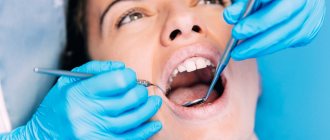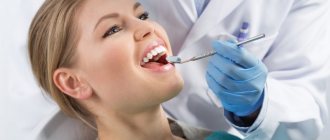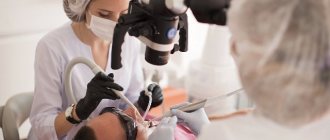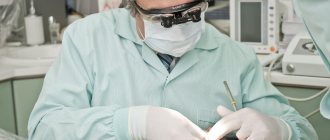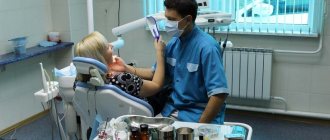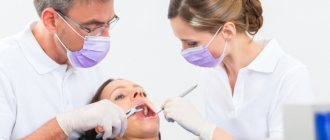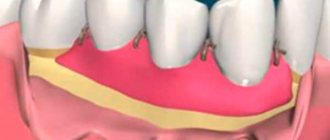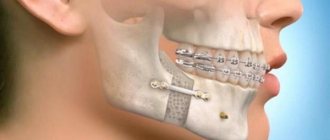Have questions?
Search for a doctor
Berezinskaya Anna Sergeevna Dentist-therapist, periodontist, doctor of the highest category Make an appointment
Vereshchaka Denis Nikolaevich Dentist-therapist, periodontist Make an appointment
Gasanova Zaira Romanovna Dentist-therapist, periodontist Make an appointment
Daurbekov Islam Isropilovich Dental surgeon, dental implantologist, periodontist Make an appointment
Zhukova Irina Petrovna Dentist-therapist, periodontist Make an appointment
Ievleva Liliya Nikolaevna Dentist-therapist, periodontist Make an appointment
Kadieva Niyat Mukailovna Dentist-therapist, periodontist. Head of the dental department at SM-Clinic on the street. Yaroslavskaya Make an appointment
Klimova Ksenia Evgenievna Dentist-therapist, periodontist Make an appointment
Kochieva Zamira Anatolyevna Dentist-therapist, periodontist Make an appointment
Martynova Elena Yurievna Dentist-therapist, periodontist, doctor of the highest medical category, Ph.D. Make an appointment
Romanova Elizaveta Aleksandrovna Dentist-therapist, periodontist Make an appointment
Rostovenko Inna Ivanovna Dentist-therapist, periodontist, dental surgeon, head of the dental department Make an appointment
Tyuryakova Natalya Aleksandrovna Dentist-therapist, periodontist Make an appointment
Tsanava Tamari Zaurievna Dentist-therapist, periodontist Make an appointment
Cherednichenko Victoria Aleksandrovna Dentist-therapist, periodontist. Head of the dental department at SM-Dentistry on the street. Yartsevskaya Make an appointment
Yurchenko Natalya Viktorovna Dentist-therapist, periodontist, orthodontist, candidate of medical sciences, head of the dental department Make an appointment
In dentistry, a periodontist deals with the diagnosis, treatment and prevention of periodontal pathologies. This word refers to all those tissues and structures that surround and fix the tooth in a certain place. Thus, the periodontium includes the bone tissue of the jaws, which contains the tooth root, the ligamentous apparatus located around it, as well as the soft tissue of the gums. According to statistics, periodontal diseases today occur in approximately half of all dental patients.
Who is a periodontist?
A periodontist is a highly qualified dentist with a higher medical education who specializes in the correction and prevention of pathologies of soft tissues that fix segments in the jaw bone. The concept of “periodontium” includes:
- mucous membranes that line the surface of the mouth;
- soft gum tissue surrounding the segments;
- periodontium is a thin layer of connective tissue between the alveolar process and the cementum of the tooth;
- dental cement - mineral tissue surrounding the root;
- alveolar process - a dental bed penetrated by capillaries and nerve endings.
Specifics of children's specialists
Children also experience periodontitis. The disease is diagnosed in approximately 3-5% of young children and adolescents, although most often it develops at the age of 9-10 years1. The problem is that the tissues of the oral cavity are still immature, constantly changing and rearranging, which is why they can react sharply to the slightest inflammation. In this case, the therapy will be little different from the treatment of an adult patient. Professional hygiene and physiotherapeutic measures will be required. Sometimes the lip frenulum is corrected if it has become one of the prerequisites for the development of periodontitis. In general, an integrated approach to diagnosis and treatment is required, since the causes may also lie in systemic pathologies.
Recently, lasers have been increasingly used to correct frenulums.
What diseases does a periodontist treat?
The area of expertise of a periodontist includes the treatment of gum diseases that have developed in periodontal tissues. The most common pathologies:
- Gingivitis is an inflammatory process of the periodontal soft tissues that occurs without disruption of the periodontal ligaments.
Only the gums are involved in the pathology. The first signs of the disease are bleeding and pain in the tissues surrounding the teeth. The pathology can occur in an acute form, which is also characterized by swelling, hyperemia of the mucous membrane, and itching. The chronic course of gingivitis causes virtually no discomfort, so a person is in no hurry to see a periodontist. Despite the asymptomatic course, the inflammatory process gradually progresses, complications arise - ulcerative-necrotic lesions, gum hypertrophy, detachment of mucosal areas, and others appear. The main cause of gingivitis is insufficient oral hygiene, which leads to the proliferation of bacteria. The periodontist usually prescribes conservative treatment, including removing plaque from teeth, using antiseptics, and antibiotics. - Periodontitis. Inflammatory periodontal disease, predominantly of an infectious nature. With periodontitis, destruction of the dentogingival ligaments occurs, and destruction of bone tissue develops. As the disease progresses, teeth begin to loosen and fall out. The disease is classified as polyetiological, since various reasons can lead to its development. Most often, the pathology develops due to the accumulation of bacterial plaque. In addition, periodontitis can occur due to poor heredity or gum injury. It often accompanies diabetes mellitus and is detected in hormonal disorders and other pathologies. A periodontist dentist, examining the mouth and jaw area, identifies the presence of periodontal pockets, bleeding, redness, swelling of the mucous membranes, and a heavy odor from the mouth.
- cavities. There is plaque on the teeth. Pus may be discharged from periodontal pockets. There is an exposure of the cervical zones of the segments, displacement of the teeth in the row, and their loosening. Treatment in the early stages is conservative, later - invasive.
- Periodontal disease. Non-inflammatory disease of periodontal tissues, characterized by a chronic course. The pathogenesis is based on circulatory dysfunction in the vessels supplying the periodontium. Violation of tissue trophism leads to the development of atrophic processes in the gum and bone tissues. Other causes of periodontal disease: malocclusion, smoking, decreased local immunity, hormonal imbalance, disruption of periodontal innervation, etc. The clinical picture of periodontal disease depends on the stage of the disease. Main symptoms: gum recession, pallor of the mucous membranes, increased spaces between units, their loosening. Bleeding gums are not typical for periodontal disease.
Treatment is aimed at strengthening the periodontium with the help of hygienic measures, drug therapy, and physiotherapy. If the degree is significant, the periodontist will suggest the surgeon
logical, orthopedic correction.
How will an appointment with a periodontist help?
Periodontitis is the most common problem in dentistry. Its main danger is the high risk of irreversible tooth loss. And not only the one around which tissue inflammation manifested itself most strongly. If you do not see a doctor in time, the inflammatory process can spread to the jaw bone. And this complication will lead to severe loosening and loss of neighboring, completely healthy teeth. Periodontists at SM-Dentistry will help prevent such an unpleasant development of the situation.
When to contact a periodontist
Patients who come to see a therapist are most often sent to the periodontist's office. After listening to complaints, collecting anamnesis, examining the oral cavity and identifying symptoms characteristic of gum disease, he gives a referral to a highly specialized specialist who is more competent in solving such problems:
- mucous membranes bleed during hygiene measures after chewing
food ania; - mucous membranes have changed color and are swollen;
- discharge of pus is noticed;
- a putrid smell appeared;
- the sensitivity of units to external stimuli has increased;
- grayish-white spots appeared on the gums;
- The intersegmental spaces have widened and food debris has become more likely to get stuck in them;
- stony deposits have formed on the enamel of the segments, a soft coating in hard-to-reach areas that cannot be removed with home hygiene products;
- there is pain while eating;
- The volume of the gums has decreased, the necks of the teeth have become exposed;
- periodontal pockets have formed;
- the teeth began to loosen;
- the position of the segments in the row has changed.
The periodontist will conduct a thorough examination, determine the periodontal status, make a reliable diagnosis, and prescribe adequate treatment. The duration and range of manipulations depends on the neglect of the process.
After completing therapy, it is necessary to visit the doctor according to the prescribed schedule for a follow-up examination and, if necessary, repeat the course of periodontal intervention. Your periodontist will help you maintain the health of your gums so that your smile can once again be admired by others.
Tips for choosing a good periodontist
In your search for a good, experienced specialist, reviews from real patients will help you - you can find them on the Internet or ask your friends for recommendations. When choosing a doctor, you should pay attention to the following points:
- length of service and work experience,
- status of the dental clinic,
- availability of modern equipment in the institution,
- variety of services offered.
It’s good if the specialist has a certificate of advanced training in “periodontology”, and it’s better than the state standard. This is confirmation that the doctor has completed specialized courses lasting at least 144 hours and has a specialized education.
Choose a specialist responsibly
It is important that the doctor is able to find a common language with the patient, win him over, and inspire confidence. To do this, you should pay attention to his communication skills, sincere interest in the problem and its solution. The psychological aspect actually plays an important role when choosing a doctor, although many do not attach much importance to it.
Cost of services
Periodontology rub.
Injections of drugs 1,200 rubles
Antiseptic treatment of pathological gum pockets, sclerosing therapy 750 rubles
Application of medications (Solcoseryl, Metrogil-denta) - fragment 700 rubles
Excision of hypertrophied papilla in the area of the 1st tooth (without anesthesia) 800 rubles
Therapeutic bandage in the area of a multi-rooted tooth 800 rubles
Treatment of gums for bleeding (1 session) 500 rubles
Flap surgery in the area of the periodontal pocket of one or two root teeth (1st tooth) 5,100 rubles
Flap surgery in the area of a multi-rooted tooth (in the area of the 1st tooth) 5,900 rubles
Medical treatment of periodontal pockets in the area of 2 teeth (Demixide, Chlorhexidine) 250 rubles
Periodontal cleaning 500 rubles
Retraction of hypertrophied gums in the area of 1 tooth 750 rubles
Frenuloplasty (with anesthesia) 5,800 rubles
Frenulectomy (with anesthesia) 5,500 rubles
Splinting of 1 tooth with light-curing composites 3,050 rubles
Periodontal cleaning, deep scaling from one jaw 1,500 rubles
Ultrasonic treatment of a pocket (1 tooth) 500 rubles
Taking a free connective tissue graft 2,200 rubles
Vestibuloplasty (including anesthesia and suturing) 8,000 rubles
Open curettage in the area of the 1st tooth 4,130 rubles
Gingivoplasty in the area of 1 tooth 2,600 rubles
Surgical lengthening of 1 tooth with osteoplasty 12,980 rubles
Surgical lengthening of 1 tooth without osteoplasty 7,080 rubles
Coronal, laterally displaced flap 5,910 rubles
Gum plastic surgery in the area of one implant using local tissues 5,080 rubles
Expert of the article you are reading:
Akhmedkhanov Said Rashidovich
Dental surgeon, general dentist, implantologist, orthopedic dentist, dental therapist.
You may also be interested in:
Insert teeth Installation of filling Implantation “All on four” Express implantation Metal-free crowns Orthodontist consultation Metal-ceramic crown Children’s orthodontist
Show more
What are the risks of periodontal disease?
When the first pelagic signs appear, it is important to immediately make an appointment with a periodontist and undergo a comprehensive examination. If you trigger a disease, it negatively affects your overall well-being. Unpleasant symptoms increase over time. Common diseases associated with periodontal disorders include:
- Gingivitis. Inflammatory gum disease. The disorder is accompanied by blueness or redness of the tissues, bleeding and bad breath. As a complication, damage to the bone tissue of the jaws develops.
- Periodontitis. A serious disease associated with inflammation of the areas that support teeth. The dentogingival junction is destroyed. The consequences of violation are extremely dangerous. In an advanced case, a person can irreversibly lose diseased and healthy teeth.
- Periodontal disease. A rather severe non-inflammatory form of the pathology. Manifests itself as a reduction in gum tissue. The roots of the teeth are exposed.
Periodontist services at the A-Medic clinic
Periodontics, as a separate field, appeared not so long ago, so it is difficult to find a highly qualified specialist with experience. A-Medic dentistry employs only experienced, highly specialized doctors who are qualified periodontists.
Prices for treatment by a periodontist in Moscow are high, which is precisely explained by the lack of professional specialists in this field. Our periodontal center offers consultation and treatment at an affordable cost.
You can find out what the price for services will be when contacting a periodontist on the dentistry website in the “prices” section. The price list provided shows the preliminary cost. The exact price for services is announced by the doctor at the initial consultation. All information can also be obtained from the consultants of the periodontology center in the dentistry itself or by telephone.
Prevention
Unlike many pathologies, gum disease can be prevented quite successfully. Preventive measures are simple and do not require any special effort.
Prevention is divided into two types:
- independent;
- professional.
Independent preventive measures include mandatory regular brushing of teeth using dental floss, rinses and other oral hygiene products. If signs of gum inflammation appear, it is recommended to rinse with antiseptic solutions.
Professional prevention consists of hygienic cleaning in a dental clinic. It is recommended to carry out such hygiene at least 2-3 times a year. Procedures can be carried out to cleanse soft and hard plaque from tooth enamel or strengthen teeth and gums through remineralization or polishing. There are other innovative techniques aimed at strengthening the periodontium.
Treatment methods
Patients of the A-Medic clinic can make an appointment with a periodontist, or for a consultation with a dental therapist, who, if indicated, will refer the patient to a more specialized specialist.
At the initial appointment, the doctor interviews the patient and examines the oral cavity. Diagnostics are possible. Based on symptoms and examination results, the doctor makes a diagnosis. Before starting treatment, it may be necessary to carry out hygienic procedures (for example, removing tartar).
Periodontist services may include both therapeutic and surgical treatment - the method depends on the diagnosis and the stage of its development.
Methods used in periodontology:
- antiseptic treatment (use of solutions of Chlorhydroxydine, Furacilin, Hydrogen Peroxide, etc.);
- antibiotic therapy (taking systemic and using local drugs);
- injections of calcium chloride into the gum papillae;
- electrophoresis with drugs;
- laser therapy (for example, gum excision);
- orthopedic (installation of bridges, prosthetics, splinting, etc.);
- remineralization (fluoridation of enamel);
- dental filling;
- taking vasotropic and antisclerotic drugs.
Surgical treatment of diseases related to periodontology can be carried out by gum resection, gingivectomy, transplantation, implantation of soft or bone tissue and plastic surgery.
What functions does periodontal tissue perform?
Periodontal tissues perform 4 important functions:
- They serve as a support for the teeth, holding them firmly in the socket, and, due to the presence of collagen fibers, they cushion, evenly distributing the load when chewing food.
- They protect the tooth root from the penetration of pathogenic microflora, which can cause severe inflammation and significant pain.
- Due to the branched capillary network, blood microcirculation is ensured in accordance with the chewing load.
- They reflexively regulate chewing pressure due to nerve endings - receptors.
Periodontal tissues are easily injured by tartar, hot foods and drinks, spicy foods, toothpicks, etc., and the oral cavity is constantly home to several hundred varieties of pathogenic microorganisms. Therefore, the consequences of injuries are infectious inflammatory diseases - gingivitis and periodontitis. Gum inflammation often has a long course and leads to serious disruptions in the functioning of the digestive, endocrine and cardiovascular systems.
In addition, every third to fifth periodontist patient suffers from periodontal disease, a dystrophic disease that also leads to gum atrophy, the causes of which are still unclear.
